by Editor | Jan 3, 2012 | Books
By Joan Leacock
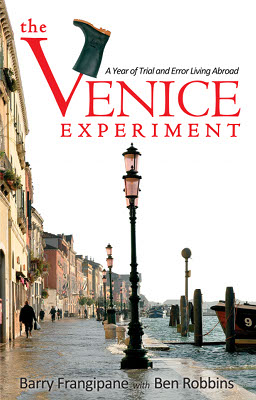
The Venice Experiment book cover
Photos: News & Experts
In this book, the author shared the story of how he quit the rat race of Florida in the United States to live as a resident of Venice, Italy. He and his wife took a year long journey, a cultural exchange from their lifestyle and expectations, and threw themselves at the mercy of living and being Venetians, experiencing the oddities of being foreigners abroad.
Having visited Venice many years ago and only vaguely remembering taking gondola rides up the Grand Canal, I found myself easily transported to the squares, bridges and streets of Venice and imagining all the characters mentioned in the book, as easily as if they were long lost friends. The Venice Experiment: A year of trial and error living abroad (Savory Adventures Publishing 2011, $14.95), a 238-page book by Barry Frangipane with Ben Robbins, captures the flavors, smells, warmth and frustrations of the year he and his wife spent living in The Floating City. I fell in love with Venice, through the eyes of the author, all over again.
Frangipane navigates the problems he encounters as a foreigner living abroad well. I laughed and moaned at the difficult situations he found himself in, as he and his wife fumbled their way through the narrow corridors of the Italian language, the city’s unique history and diverse personalities.

Barry Frangipane, author, The Venice Experiment
The book provides a concierge service of do’s and don’ts surrounding the legalities of moving to Venice. It became a fun expose of the complexities he experienced with language, assumptions and misinterpretations of cultural norms and, in particular, time management as he wondered at the beginning of their adventure, “Would I learn to see things from their perspective? Given a whole year to figure it out, how hard could it possibly be?”
Overall, I found this book to be an easy read with wonderful references to use and visit should I ever find myself in that part of the world. It is a quaint, funny and informal source of relevant information. The author provides a humorous induction of his move to this city, by cleverly disguising and exposing the red tape that he encountered. I was left with a comprehensive checklist of doable tasks in relation to the transferring of pets, visa requirements, how not to organize a lease for an apartment, the choice of ground floor versus first floor apartments, postal boxes, water taxis, vehicle parking and where to purchase everyday items in unexpected places.
by Editor | Nov 22, 2010 | Books
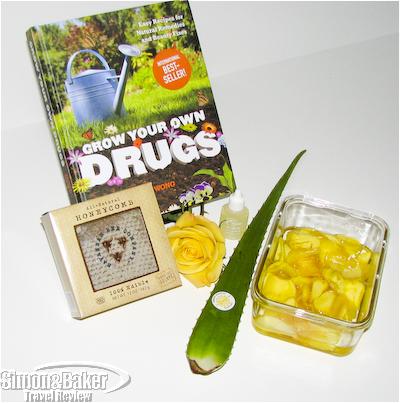
Ingredients for chapped lips balm recipe
Herbal enthusiasts wishing to find home remedies for simple maladies have a new resource, Grow Your Drugs: Easy Recipes for Natural Remedies and Beauty Fixes (Reader’s Digest, $19.95) by James Wong, host of a BBC series by the same name. There are 60 recipes for natural teas, creams, lotions, balms, gargles and cough syrups in the 224-page hardcover book with 150 color photos published earlier this year.
Many of the recipes are accompanied by color photos and step-by-step instructions. The book is divided into: Introduction, Getting Started, Remedies, Top 100 Medicinal Plants, Resources, Index and Acknowledgements. Wong provides recipes to deal with skin ailments including Athlete’s foot, eczema, insect bites and stings, acne, sunburn, age spots, fungal conditions, burn scars, poor foot circulation and chapped hands; digestive issues like bad breath, heartburn and indigestion, irritable bowel syndrome, constipation, flatulence, and diarrhea; children’s needs such as vitamin booster, head lice, ear wax build-up, and colic; Aches and Pains: Water retention, varicose veins, aching muscles, arthritis; and women’s problems like hot flashes, night sweats, morning and travel sickness, PMS, and cystitis.
He also offers suggestions for colds and flu, coughs and sore throats, cholesterol reduction, hangover, cold sores, immune system booster, mouth ulcers, restorative, memory enhancer, insomnia, migraine prevention, anxiety, hair strengthener, body scrub, bath and massage oil, deodorant, face mask, hand care, exfoliator, face toner and hair rinse, tired or red eyes, glycerin soap, plaque remover and gum soother, and chapped lips.
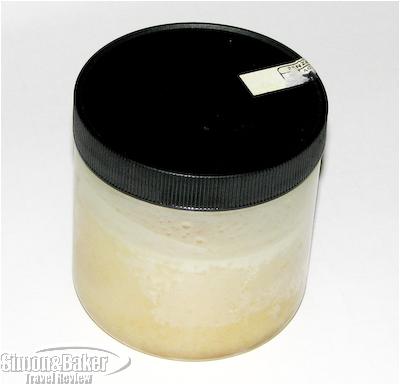
We placed the lip balm in a glass jar with a wide neck and kept it refrigerated
We tried the chapped lips recipe which required organic and fragrant rose petals, vitamin E oil, bees wax, honey, cheesecloth and aloe vera gel (optional). The biggest challenge was obtaining organic fragrant rose petals in our area. We located organic roses at the local branch of a national health food chain although the fragrance was rather muted. We couldn’t find bees wax so we substituted honeycomb for the bees wax. The resulting balm solidified in the refrigerator although it seemed too soft to carry around.
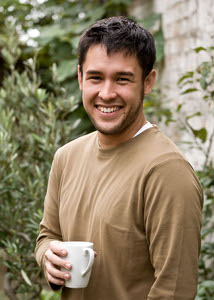
Author James Wong
James Wong, who grew up in Malaysia and Singapore, trained at the Royal Botanical Gardens, Kew and received an MSc in Ethnobotany from the University of Kent graduating with distinction. His research has taken him to highland Ecuador, as well as to China and Java. The University of Kent lecturer, an enthusiast about the utilitarian value of plants, co-designed and built two medal-winning gardens (in 2004 as the youngest medal winner and again in 2008).

Click here to buy Grow Your Own Drugs
by Editor | Jul 5, 2010 | Books, Food
Article and photos by Gary Cox
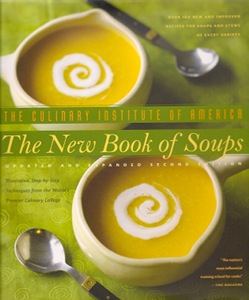
The New Book of Soups
Soup is a universal food. From the earliest days of mankind with an iron pot dangling over the fire to modern cuisine in the most exclusive restaurants, soup is one of the most versatile and flexible forms of cooking. The extraction, blending and concentration of flavors in liquid form can be a quiet challenging medium for the novice and experienced chef alike. It has been said that the best way to judge the capabilities of a new chef is to have him or her make a soup with the ingredients on hand.
Reviewing a cookbook can be a challenge, particularly one that requires the reader to possess specific skills or a talent for cooking. What I liked about The New Book of Soups (Lebhar-Friedman Book, $35) by the Culinary Institute of America is that it is well organized, making easy to pick up and start cooking. Also, there is quite a bit of information in the front of the book on processing ingredients, making stock and other topics useful for various skill levels.
It was gratifying to find that even having skipped past all the preparatory material, the recipes still produced great tasting results. We tried the Double Chicken Broth recipe and found it excellent and a memorable addition to our ongoing repertoire. Even substituting a mixture of mushrooms for the shitake ones in the recipe, the resulting soup was tasty and disappeared quickly.
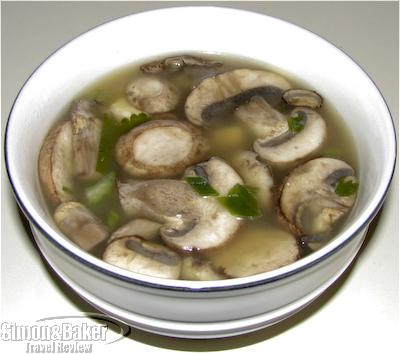
Double Chicken Broth Soup made following the recipe in The New Book of Soups
An excellent test of a cookbook is to make a familiar classic recipe and evaluate the flavors and ease of performing the recipe steps. The next soup I made was the Onion Soup Gratinee, a rendition of the classic French onion soup. The instructions were easy to follow and produced a terrific tasting soup using easily obtainable ingredients. This time of year, Vidalia onions are widely available and they resulted in a slightly sweet and flavorful rendition of this longtime favorite.

The ingredients for the Onion Soup Gratinee

Our version of the Onion Soup Gratinee based on the recipe in The New Book of Soups
There are still many recipes I look forward to trying in this second edition of the 249-page The New Book of Soups. The book is divided into Soup Basics, Broths, Hearty Soups, Stews, Cream Soups, Pureed Soups, Bisques and Chowders, Cold Soups, and Accompaniments sections with many full color photos to illustrate the desired end result. I might even rely on the material in the front and take a lash at making my own stock or some of the other basics to improve my overall skills. It is not necessary to study the basics to get great results, but it is nice to know they are there if I have questions or an interest. Excellent for the beginner or perhaps even for experienced chefs, this cookbook makes a great addition to my library.
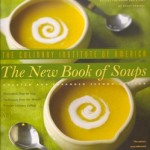
Click here to buy The New Book of Soups
by Editor | Jun 7, 2010 | Books

Part of the Pride My Life Among the Big Cats of Africa book cover
Although Kevin Richardson had a reasonably normal childhood in Johannesburg, South Africa as an adult he became extraordinary by virtue of his ability to interact safely (mostly) with predators in captivity. Lest we think rubbing nose to nose with male and female lions and hyenas in an enclosure, handling a lion cub while sharing space in the same enclosure with the lioness mum, filming commercials and entire feature length movies, often outside the safety of a park enclosure, is something any zoo staff member can do, it’s not.
It is dangerous work. No one, not even Kevin Richardson, denies that. How and why is this possible? In Part of the Pride My Life Among the Big Cats of Africa, published in 2009 (St. Martin’s Press, $25.99) he discusses his growing years and the path that led him to his amazing interactions with some of Africa’s big cats raised in captivity at the South African Lion Park and the Kingdom of the White Lion. With the help of Author Tony Park, he shares his experience as a self taught lion whisperer.

Kevin Richardson with his lion family (back cover of the book)
The 243-page hardcover book, easy to read in his candid first person style, is divided into 14 chapters, a prologue and an epilogue. For lion lovers and fans of Richardson’s work (some videos on YouTube show him in action) the book answers many questions. It made us eager to watch the two film projects mentioned in the book including White Lion: Home Is a Journey due out soon.
Photos courtesy of St. Martin’s Press

Click to buy Part of the Pride: My Life Among the Big Cats of Africa
by Editor | Jul 27, 2009 | Accomodations, Books, Ecotourism, Luxury Travel, New Articles, Products, Restaurants, Spas

Lions at Rattray's
Many travelers familiar with luxury safari lodges in South Africa know of or may have stayed at the Mala Mala Reserve, one of the oldest reserves within the larger Sabi Sand Reserve. The well known reserve fronts a fenceless portion of the http://simonandbaker.com/kruger.

A vigilant kitty at Rattray's
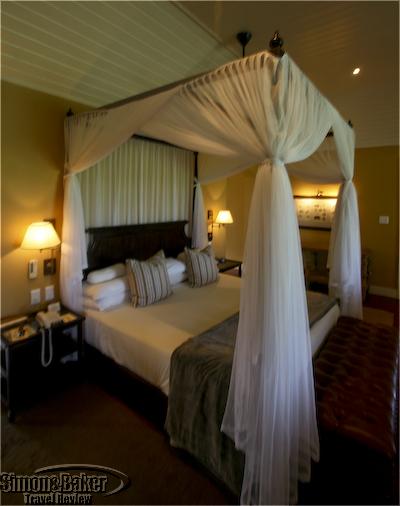
Our team's suite at Rattray's
The family owned property offers accommodations for 54 guests in the Mala Mala Main Camp . Nearby there are exclusive luxury accommodations at Rattray’s, an eight suite fenced lodge for guests 16 and older with a fitness center and swimming pool. Click here to read about our team’s impressions during their most recent visit in a dedicated article about Rattray’s.
by Editor | Mar 30, 2009 | Books, Luxury Travel
Article by Elena del Valle and photos by Gary Cox

Tao buddha
Except for the near empty state of the large restaurant (we arrived in the late afternoon) it would have been hard to tell what time of day or night it was inside Tao Asian Bistro (3377 Las Vegas Blvd. South, Las Vegas, NV 89109, +1-702-388-8338, Taolasvegas.com). Such was the style of the nightclub and bistro which could accommodate 2,000 guests. Located at The Venetian Resort-Hotel-Casino, the two-story restaurant was crawling with shadows that made it appear mysterious. Done in a slightly different way it could have felt soulless but bright shades of red, brick walls, kanji characters reflected on the ceiling and larger than life decorative oriental artifacts lent it a certain magic. It had the air of a place that comes alive with patrons, especially in the evening.
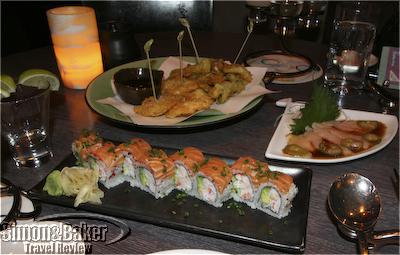
Tao appetizers
The hostess led us to the last booth, tucked away next to the kitchen door and across from a giant Buddha. Chris, our friendly and knowledgeable server, was with us moments later. At his suggestion, we tried two martinis: Tao-tini (Absolute Mandarin, Stoli Rasberry, Malibu Rum, cranberry and fresh lime juice) and a Lychee Martini (Ketel One, Triple and fresh luchee puree). For starters we shared the Yellowtail Sashimi with Jalapeño and Ponzu Sauce (a favorite); Alaskan Salmon, Crab and Avocado Roll; Kimchee and Baby Shanghai Bok Choy with Garlic.
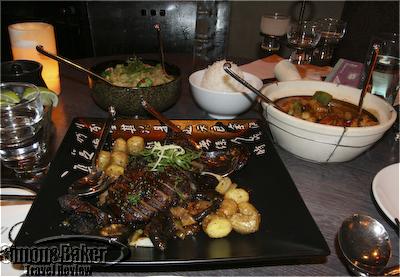
Wok Seared New York Sirloin with Shiitake Mushrooms and Szechwan Potatoes

View of the Tao dining room from our seats
Then, our main courses arrived, a mountain of tasty food: Satay of Chilean Sea Bass with Wok Roasted Asparagus (a favorite); Lobster Wontons with Shiitake Ginger Broth; Sandpot Lobster, Shrimp and Scallops with Black Bean Sauce; Wok Seared New York Sirloin with Shiitake Mushrooms and Szechwan Potatoes; Jasmine White Rice, and Mandarin Sizzled Fried Rice with Duck. Chris recommended an ice cream dessert which we enjoyed. These culinary creations were the work of Mark Andelbradt, Tao’s executive chef, and Koji Noda, the executive sushi chef, and their staff.
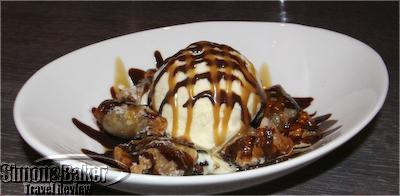
Our dessert
We washed it all down with six types of sake (Chris recommended this) including three “crazy fun” ones. He brought us the Spirit and Eternal selections from the sake by the glass menu. As we headed to our show (that’s why we arrived so early), the thought occured to me that although we sampled lots of savory dishes and drinks we would were pleasantly satisfied. We had a fun and enjoyable dinner at Tao.






























